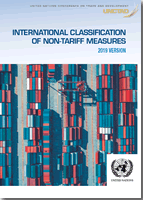The official definition of NTMs is broad: NTMs are policy measures other than ordinary customs tariffs that can potentially have an economic effect on international trade in goods, changing quantities traded, or prices or both. A detailed classification is therefore critical in order to clearly identify and distinguish among the various forms of NTMs.
The MAST group extensively discussed and developed the International Classification of NTMs between 2007 – 2017. It agreed upon the first version of this classification in 2012. Later the classification was further developed and finalized in 2017 with Chapter J-O fully developed. The classification is ever evolving and adapting to the reality of international trade and data collection needs.
The International Classification of NTMs follows a taxonomy of all measures considered relevant in today's international trade. It comprises technical measures, such as sanitary or environmental protection measures. Moreover, it also includes other measures traditionally used as instruments of commercial policy, e.g. quotas, price control, exports restrictions, or contingent trade protective measures. Finally, the International Classification of NTMs also comprises behind-the-border measures, such as competition, trade-related investment measures, government procurement or distribution restrictions.
The classification does not judge on legitimacy, adequacy, necessity or discrimination of any form of policy intervention used in international trade. It acknowledges existence and is designed to organize information in a database format.
Examples of NTMs
- Sanitary and Phytosanitary Measures
-
Measures that are applied to protect human or animal life from risks arising from: additives, contaminants, toxins or disease-causing organisms in food.
-
A requirement limiting the use of hormones and antibiotics in the production of meat
-
A sample test on imported oranges to check for the residue level of pesticides
-
- Technical Barriers to Trade
-
Measures referring to technical regulations, and procedures for assessment of conformity with technical regulations and standards.
-
Restrictions on toxins in children's toys
-
Refrigerators need to carry a label indicating their size, weight and electricity consumption level
-
- Pre-shipment Inspection and Other Formalities
-
-
Live animals need to be cleared at a designated customs office for inspection
-
Requirement that goods must be shipped directly from the country of origin, without stopping at a third country
-
- Contingent Trade-protective Measures
-
Measures implemented to counteract particular adverse effects of imports in the market of the importing country contingent upon the fulfilment of certain procedural and substantive requirements.
-
Country A imposes an anti-dumping duty on imports of biodiesel products from country B, to offset an injurious dumping by country B found to exist via an investigation.
-
Country A imposes a countervailing duty on imports of semiconductors from country B, to offset the subsidies granted by country B on the production of semiconductors found to exist via an investigation
-
- Non-automatic Licensing, Quotas, Prohibitions &Amp; Quantity-control
-
Control measures generally aimed at restraining the quantity of goods that be imported.
-
Only hotels and restaurants are allowed to import alcoholic drinks
-
A quota of 100 tons of tuna fish can be imported any time of the year
-
- Price-control Measures
-
Measures implemented to control or affect the prices of imported goods.
-
A minimum import price is established for fabric and apparel
-
Imports of fresh blueberries may enter free of duty between 1 January to 31 May, while in other months seasonal duties apply
-
- Export-related Measures
-
Export-related measures are measures applied by the government of the exporting country on exported goods.
-
Exports of processed sea food products must be inspected for sanitary conditions
-
Exports of cultural heritage objects - sculptures or precious - are prohibited
-



